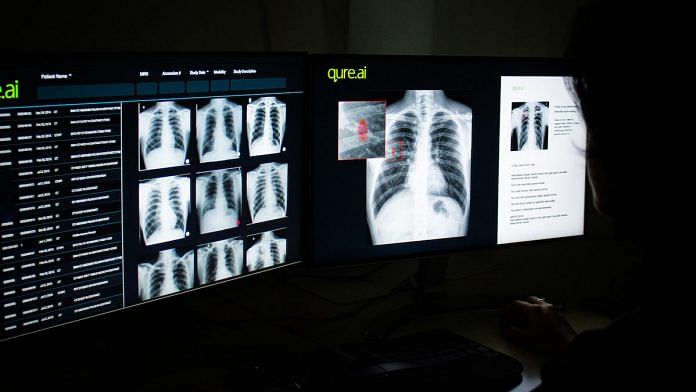New Delhi: The National Informatics Centre (NIC) is working on an Artificial Intelligence (AI)-based diagnostic prototype for early detection of Covid-19 disease using chest X-rays.
The innovative solution could help in early detection through remote diagnosis thereby facilitating timely isolation of patients and a treatment plan for their speed recovery, government officials familiar with the development told ThePrint.
The Centre of Excellence in Artificial Intelligence of the National Informatics Centre (NIC), an office attached to the Ministry of Electronics and Information Technology (Meity), has been working on the prototype.
While the work is still in a nascent stage, NIC officials feel this could revolutionise Covid-19 diagnosis as it will make it possible for radiologists and doctors to detect infection even in asymptomatic patients and prioritise their treatment. At present, detecting Covid-19 in asymptomatic patients is proving to be a big challenge for healthcare workers.
“The AI model will be trained by using a large amount of data (X-ray images), after which it can be deployed to assist radiologists and doctors. Once trained, the AI model will be able to make predictions for X-ray images within a short span,” a senior NIC official told ThePrint.
Across the world, many countries, including in Europe, the USA and Japan are working on developing an AI model that uses chest X-rays to diagnose Covid-19 cases.
The NIC will be using its CORS (CollabDDS Online Radiological Services) platform, based on its advanced teleradiology application and CollabDDS (Collaborative Digital Diagnosis System), which provides a real-time collaborative environment to visualise X-Ray images and DICOM data for radiological diagnosis.
Niti Aayog, the federal think-tank, is coordinating with Meity on the project. “This is a potential area. It’s a technology that is feasible. Meity is working on it. Other institutions like the IITs have also shown interest in developing such technology,” V.K. Paul, Niti Aayog member, told ThePrint.
Also read: Bengaluru start-up’s AI tool can help analyse extent of lung damage in Covid-19 patients
How the AI model will work
Once the chest X-rays are uploaded by a hospital, health care centre or others, they will be transmitted securely to the NIC’s data centre with only a patient ID as a reference to the image so that the prediction can go back to the uploading unit.
To start with, NIC is talking with a few medical institutes across the country to get them to share chest X-rays of their patients for training the model. “We will need basic X-rays to train the model as per Indian demography. Once the AI model is trained, it could be deployed, subject to approval by ICMR,” said a second NIC official.
“With the Covid-19 pandemic posing a global challenge to the health of individuals, the government is fully dedicated to using technology-led innovation for its fight against Covid-19,” the official added. “In the days to come, NIC is hopeful that if the results are satisfactory, the government will support the deployment of AI models in various states for speedy diagnosis of Covid-19 patients.”
How NIC is using AI in the battle against Covid-19
This is not the only way that AI is being deployed by the government in the fight against Covid-19.
Using AI, NIC is also working on providing virtual OPD (out-patient department) facilities in a few hospitals.
Once the virtual OPD system, which will use Interactive Voice Response System, is ready, patients will be able to call the doctors/ specialist at a time provided by the hospital to get medical advice related to their illness on a landline or a mobile phone.
Having a mobile phone is a must as a prescription will be sent to the patient in the form of a short message service (SMS). This will ensure the patients don’t have to visit the hospital to get their prescription extended.
Doctors will be able to provide prescriptions over email or through SMS after verifying the caller. Using a chatbot, a user will also be able to text chat on the portal and get information on Covid-19.
Apart from this, the NIC has also developed a chatbot for the Meghalaya government in three languages — English, Khasi and Garo — to answer any queries from the local residents related to Covid-19. The chatbot also provides information like what causes Covid-19, its symptoms, where one can go if he/she has symptoms, the helpline number that one can call, etc. After Meghalaya, NIC is now helping the Jharkhand government develop a similar chatbot in English and Hindi.
“As new pandemics arise, the world is rapidly moving to adapting new concepts like using genomic studies of the virus and its mutants for developing vaccines early,” Nagesh Shastri, Deputy Director General, NIC told ThePrint. “There is a lot of information, which is impossible for mere humans to assimilate and search for patterns. This is where emerging technologies like AI can be harnessed to augment the intelligence available to human, and as a technology savvy organisation, it is our endeavour to help Indian government in its fight against Covid-19.”
Also read: Why Modi govt dropped the idea of transferring cash to migrant workers during lockdown




